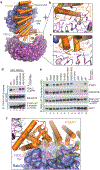GGTase3 is a newly identified geranylgeranyltransferase targeting a ubiquitin ligase
- PMID: 31209342
- PMCID: PMC6609460
- DOI: 10.1038/s41594-019-0249-3
GGTase3 is a newly identified geranylgeranyltransferase targeting a ubiquitin ligase
Abstract
Protein prenylation is believed to be catalyzed by three heterodimeric enzymes: FTase, GGTase1 and GGTase2. Here we report the identification of a previously unknown human prenyltransferase complex consisting of an orphan prenyltransferase α-subunit, PTAR1, and the catalytic β-subunit of GGTase2, RabGGTB. This enzyme, which we named GGTase3, geranylgeranylates FBXL2 to allow its localization at cell membranes, where this ubiquitin ligase mediates the polyubiquitylation of membrane-anchored proteins. In cells, FBXL2 is specifically recognized by GGTase3 despite having a typical carboxy-terminal CaaX prenylation motif that is predicted to be recognized by GGTase1. Our crystal structure analysis of the full-length GGTase3-FBXL2-SKP1 complex reveals an extensive multivalent interface specifically formed between the leucine-rich repeat domain of FBXL2 and PTAR1, which unmasks the structural basis of the substrate-enzyme specificity. By uncovering a missing prenyltransferase and its unique mode of substrate recognition, our findings call for a revision of the 'prenylation code'.
Conflict of interest statement
Competing Interests:
The authors declare no competing financial interests. M.P. is a consultant for BeyondSpring Pharmaceuticals and a member of the scientific advisory boards of CullGen, Inc. and Kymera Therapeutics. N.Z. is a member of the scientific advisory board of Kymera Therapeutics.
Figures





Similar articles
-
A SNARE geranylgeranyltransferase essential for the organization of the Golgi apparatus.EMBO J. 2020 Apr 15;39(8):e104120. doi: 10.15252/embj.2019104120. Epub 2020 Mar 3. EMBO J. 2020. PMID: 32128853 Free PMC article.
-
Double prenylation of SNARE protein Ykt6 is required for lysosomal hydrolase trafficking.J Biochem. 2021 Apr 18;169(3):363-370. doi: 10.1093/jb/mvaa111. J Biochem. 2021. PMID: 33035318
-
Restricted substrate specificity for the geranylgeranyltransferase-I enzyme in Cryptococcus neoformans: implications for virulence.Eukaryot Cell. 2013 Nov;12(11):1462-71. doi: 10.1128/EC.00193-13. Epub 2013 Sep 6. Eukaryot Cell. 2013. PMID: 24014765 Free PMC article.
-
Protein prenylation: a pivotal posttranslational process.Biochem Biophys Res Commun. 2003 Mar 28;303(1):1-7. doi: 10.1016/s0006-291x(03)00323-1. Biochem Biophys Res Commun. 2003. PMID: 12646157 Review. No abstract available.
-
Thematic review series: lipid posttranslational modifications. Structural biology of protein farnesyltransferase and geranylgeranyltransferase type I.J Lipid Res. 2006 Apr;47(4):681-99. doi: 10.1194/jlr.R600002-JLR200. Epub 2006 Feb 13. J Lipid Res. 2006. PMID: 16477080 Review.
Cited by
-
Cullin-RING Ubiquitin Ligase Regulatory Circuits: A Quarter Century Beyond the F-Box Hypothesis.Annu Rev Biochem. 2021 Jun 20;90:403-429. doi: 10.1146/annurev-biochem-090120-013613. Epub 2021 Apr 6. Annu Rev Biochem. 2021. PMID: 33823649 Free PMC article. Review.
-
Nse5/6 inhibits the Smc5/6 ATPase and modulates DNA substrate binding.EMBO J. 2021 Aug 2;40(15):e107807. doi: 10.15252/embj.2021107807. Epub 2021 Jun 30. EMBO J. 2021. PMID: 34191293 Free PMC article.
-
Nuclear Morphological Remodeling in Human Granulocytes Is Linked to Prenylation Independently from Cytoskeleton.Cells. 2020 Nov 20;9(11):2509. doi: 10.3390/cells9112509. Cells. 2020. PMID: 33233551 Free PMC article.
-
Protein Prenylation in Plants: Mechanisms and Functional Implications.Plants (Basel). 2025 Jun 9;14(12):1759. doi: 10.3390/plants14121759. Plants (Basel). 2025. PMID: 40573747 Free PMC article. Review.
-
Analyzing the postulated inhibitory effect of Manumycin A on farnesyltransferase.Front Chem. 2022 Dec 6;10:967947. doi: 10.3389/fchem.2022.967947. eCollection 2022. Front Chem. 2022. PMID: 36561140 Free PMC article.
References
Methods-only References
-
- Otwinowski Z & Minor W in Methods in Enzymology Vol. 276 (eds Carter CW & Sweet RM) 307–326 (Academic Press, New York, 1997). - PubMed
-
- CCP4. The CCP4 Suite: programs for protein crystallography. Acta Crystallogr D Biol Crystallogr D50, 760–763 (1994). - PubMed
-
- Adams PD et al. PHENIX: building new software for automated crystallographic structure determination. Acta Crystallogr D Biol Crystallogr 58, 1948–1954, doi:S0907444902016657 [pii] (2002). - PubMed
Publication types
MeSH terms
Substances
Grants and funding
LinkOut - more resources
Full Text Sources
Molecular Biology Databases
Research Materials
Miscellaneous

